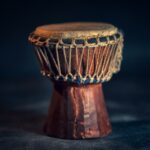Are you ready to unveil the rhythmic secrets of drumming? Get ready to dive into a world of fascinating did you know facts about drums. In this article, we uncover the hidden stories behind this versatile instrument, delving into its history, techniques, and its impact in various genres and cultures. As a highly skilled SEO content writer, I am thrilled to share these intriguing tidbits with you, showcasing the diversity and significance of drumming throughout the ages. So, sit back, relax, and prepare to be amazed by the rhythmic wonders that await you in [Fascinating Did You Know Facts About Drumming: Uncovering the Rhythmic Secrets].

Did You Know Facts About Drum?
Drumming is an ancient art that has stood the test of time. From its humble origins to its diverse present, drums have captivated cultures and music enthusiasts around the world. This article explores some fascinating did you know facts about drumming that will leave you amazed and intrigued.
1. Evolution of Drums: Did you know that drums are over seven thousand years old? They are one of the oldest instruments invented by mankind. From simple hollowed logs to intricate drum sets, drums have evolved over time, becoming an integral part of various musical genres and cultures.
2. Components of a Drum Set: When we think of drums, we often picture a drum set. But did you know that an average drum set consists of three main types of drums? The bass drum, which produces low, booming sounds; the snare drum, known for its sharp and distinctive sound; and the floor tom, a larger drum that adds depth to the rhythm.
“From the deep thump of the bass drum to the crisp crack of the snare drum, each component of a drum set contributes to the unique sound and feel of the instrument.”
3. Drumming as Communication: Before the invention of phones, drums were used as a long-distance communication system. African and European drummers employed the rhythm of the drums to send messages across vast distances, reaching villages and communities. This fascinating use of drums showcases their versatility and ability to bridge gaps.
4. The Alligator Drum: Drum’s history is entwined with ancient civilizations, and the oldest drum ever discovered is the Alligator Drum. Dating back as early as 5500 BC, this drum was used in Neolithic China for shamanistic purposes and rituals. Made from clay and alligator hides, it provides a fascinating glimpse into the early origins of drumming.
5. Drumming for Health: Drumming isn’t just about creating captivating rhythms; it also has numerous health benefits. Did you know that drumming can burn more calories than weightlifting, hiking, or cycling in the same amount of time? It’s a full-body workout that improves brain health, boosts immunity, and lowers blood pressure. So, the next time you pick up drumsticks, know that you’re not only creating music but also taking care of your well-being.
6. The Grandeur of a Massive Drum Set: Prepare to be awed by the world’s largest drum set, consisting of a mind-boggling 813 pieces! It took 36 years to build this colossal collection of drums, cymbals, and other percussion instruments. This awe-inspiring accomplishment pushes the boundaries of what’s possible in the world of drumming.
7. Mastering the Art of Drumming: Drumming isn’t just about hitting the drums randomly; it requires skill and precision. Drummers must possess limb independence, eye-hand coordination, and a keen sense of rhythm. It takes years of practice and dedication to become a proficient drummer who can seamlessly weave intricate rhythms and grooves.
8. Breaking Records with Drumming: Drummers are known for their endurance and determination. In Indonesia, Kunto Hartono holds the record for the longest drumming session, lasting a staggering 122 hours and 25 minutes! This remarkable feat showcases the incredible physical and mental stamina required to push the boundaries of drumming.
9. Drums in Every Civilization: Throughout history, drums have been an integral part of civilizations worldwide. Drumming has been featured in various ceremonies and rituals, symbolizing joy, celebration, and connection with the divine. From ancient civilizations to modern-day cultures, drums have transcended boundaries and united people with their universal language of rhythm.
10. Age is Just a Number: Viola Smith is a testament to the timeless nature of drumming. At the age of 107, she is recognized as the world’s oldest drummer. Her passion for drumming and her ability to inspire others showcases that no matter our age, music has the power to keep us vibrant and connected.
“The rhythmic heartbeat of drums has echoed throughout history, bringing people together, promoting well-being, and inspiring generations.”
These captivating did you know facts about drumming highlight the instrument’s rich history, its impact on communication and culture, and its numerous health benefits. So, the next time you tap your foot to a catchy beat or get lost in the rhythm of a drum solo, remember the rhythmic secrets and fascinating stories that drums carry within them.
Drums have been captivating audiences for centuries, and there’s always something new to discover about these fascinating instruments. If you’re a music lover or simply curious about percussion, you won’t want to miss out on these fun facts about drums. From their ancient origins to their modern-day variations, drums have played a crucial role in cultures all around the world. So, click here to uncover some intriguing information and expand your knowledge on the rhythmic world of drums! fun facts about drums
to practice your drumming skills, but it’s equally important to develop your musical ear and understanding of music as a whole. By taking the time to sit and listen to music through headphones, you can train your ear to recognize different rhythms, styles, and dynamics. This will not only make you a better drummer but also allow you to better support the music you’re playing.
[youtube v=”gHIZELwH49k”]
Number two: Don’t be afraid to make mistakes. As a beginner drummer, it’s natural to feel a bit self-conscious and worried about making mistakes. However, making mistakes is an essential part of the learning process. It’s how we grow and improve. Embrace the mistakes and view them as opportunities to learn and get better. Remember, even the most experienced drummers make mistakes, so don’t be too hard on yourself.
And finally, number one: Practice with intention and purpose. It’s not about how long you practice, but rather how effectively you practice. Make sure every practice session has a clear goal and focus. Whether it’s working on a particular drumming technique, learning a new song, or improving your timing, having a purposeful practice routine will yield better results than mindlessly playing without direction.
In conclusion, drumming is an art that requires dedication, patience, and a continual pursuit of improvement. By following these twelve tips, you can set yourself on the path to becoming a skilled and successful drummer. Remember to prioritize musicality over technicality, listen and learn from yourself, relax, and enjoy the music you’re playing. And above all, practice with intention and purpose. With these tips in mind, you’ll be well-equipped to navigate the world of drumming and reach new heights in your musical journey.

FAQ
Q: How old are drums?
A: Drums are seven thousand years old and one of the oldest instruments invented by mankind.
Q: What are the types of drums in an average drum set?
A: An average drum set contains three different types of drums: the bass drum, snare drum, and floor tom.
Q: Have drums been used for communication?
A: Yes, drums have been used for long-distance communication. African and European drummers used them as a form of wireless communication system before the invention of phones.
Q: What is the oldest drum ever discovered?
A: The oldest drum to be discovered is the Alligator Drum, which was used in Neolithic China and dates back as early as 5500 BC. It was made from clay and alligator hides and used for shamanistic purposes and rituals.
Q: How does drumming benefit health?
A: Drumming improves brain and physical health, burning more calories than weightlifting, hiking, or cycling in the same amount of time. It also boosts one’s immunity and lowers blood pressure.
- Unlock Water’s Symbolism: A Cross-Cultural Exploration - April 20, 2025
- Identify Black and White Snakes: Venomous or Harmless? - April 20, 2025
- Unlocking Potential: Origins High School’s NYC Story - April 20, 2025















